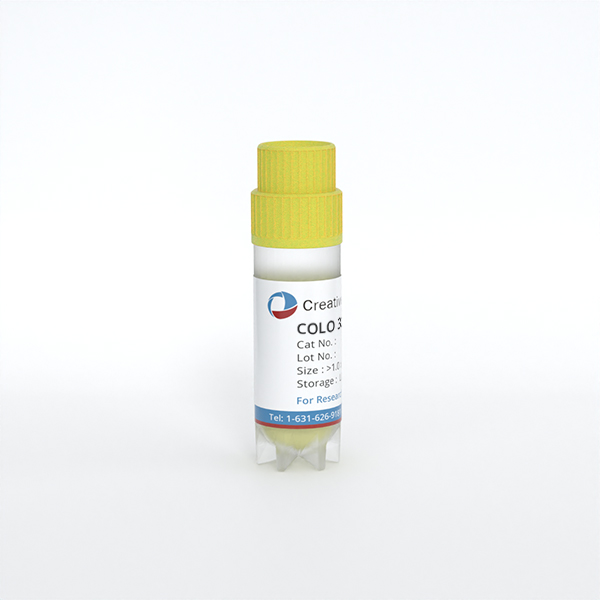Featured Products
Our Promise to You
Guaranteed product quality, expert customer support

ONLINE INQUIRY

HuG1-N
Cat.No.: CSC-C6408J
Species: Human
Morphology: lymphocyte-like
Culture Properties: Suspension cells
- Specification
- Background
- Scientific Data
- Q & A
- Customer Review
Store in liquid nitrogen.
The HuG1-N cell line is a human gastric cancer cell line that is notable for producing a specific isoform of the enzyme alkaline phosphatase (ALP), known as the Nagao-type ALP. ALP is an enzyme that is involved in various physiological processes, and its expression is often altered in various disease states, including cancer. The Nagao-type ALP is a particular isoform of this enzyme that is associated with certain types of gastric and intestinal cancers.
By studying the HuG1-N cell line, researchers can gain insights into the role of the Nagao-type ALP in the context of gastric cancer. This information may help identify potential biomarkers or therapeutic targets related to this specific isoform of the enzyme, which could ultimately lead to the development of improved diagnostic and treatment strategies for gastric cancer patients.
Genes Commonly Modulated by Atra in G-INT Cell Lines
All-trans retinoic acid (ATRA) is one of the active metabolites of vitamin A. ATRA may have significant therapeutic potential also in the context of solid tumors, including gastric cancer. To evaluate possible associations with ATRA-sensitivity, RNA-seq studies were performed with 5 genomic-intestinal (G-INT) cell lines (MKN45, AGS, NCI-N87, HuG1-N, and OCUM-1) exposed to ATRA for 48 h, which are characterized by low ATRA-sensitivity (ATRA-score < 0.55). The 5 cell lines respond to ATRA with the up-/down-regulation of several hundred genes (Fig. 1A). Nevertheless, the number of commonly up-/down-regulated genes is limited to 24 and 3, respectively (Fig. 1A and B). Interestingly, 8 genes (BGALT5/SRI/EPB41L1/TINAGL1/LARGE1/SQSTM1/STK39/DHRS3), are up-regulated in both G-INT cells showing low and high ATRA-sensitivity.
 Fig. 1 The G-INT/retinoid-resistant MKN45/NCI-N87/AGS/OCUM-1/HuG1-N cell lines were exposed to vehicle (DMSO) or ATRA (1.0 µM) for 48 hours and subjected to RNA-Seq analysis. (Guarrera L, et al., 2023)
Fig. 1 The G-INT/retinoid-resistant MKN45/NCI-N87/AGS/OCUM-1/HuG1-N cell lines were exposed to vehicle (DMSO) or ATRA (1.0 µM) for 48 hours and subjected to RNA-Seq analysis. (Guarrera L, et al., 2023)
Tumor cells are not easily cultured to form stable cell lines in vitro, so special measures should be taken to obtain good culture results, such as adding a special substrate or adding cell growth-promoting factors, or even needing to inoculate tumors with animal transfer first to obtain better activity.
The HuG1-N cell line is notable for producing a specific isoform of the enzyme alkaline phosphatase, known as the Nagao-type alkaline phosphatase.
The Nagao-type alkaline phosphatase is associated with certain types of gastric and intestinal cancers, making the HuG1-N cell line a valuable model for studying the role of this enzyme isoform in the pathogenesis of gastric cancer.
The recommended incubation medium for HuG1-N cells is 90% RPMI-1640 + 10% h.i. FBS.
Ask a Question
Average Rating: 5.0 | 3 Scientist has reviewed this product
Appreciative
I was so appreciative of the expertise and enthusiasm of Creative Bioarray. I would highly recommend them to other researchers.
16 Mar 2021
Ease of use
After sales services
Value for money
No contamination
The cells arrived promptly and were in excellent condition, with no signs of contamination or viability issues.
12 Feb 2024
Ease of use
After sales services
Value for money
Valuable tools
The ability to work with this unique cell line that produces the Nagao-type alkaline phosphatase has opened up new avenues of investigation for my team.
27 May 2024
Ease of use
After sales services
Value for money
Write your own review
- You May Also Need







